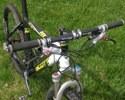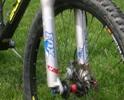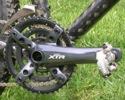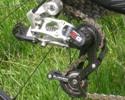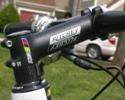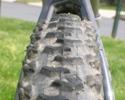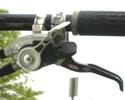
Recently on Cyclingnews.com |
On test: Scott Scale 10, May 14, 2006
All-pro carbon hardtail
The Scale 10 is Scott's off-road equivalent of the CR-1 road bike - a very light, stiff carbon fibre frame designed for one thing and one thing only: going fast. Cyclingnews MTB Editor Steve Medcroft has been giving the Scale 10 an extended test ride.

|
In the age of bicycle specialization it sometimes feels like some bike formats receive more attention than others. An expanding selection of frame materials, advancements in component and wheel technology and reductions in frame and component weight have made the road bike a slim, powerful shell of what existed only ten years ago. In mountain biking, adaptation of suspension and braking technologies from other industries has upped the performance and dropped the weight of full-suspension off-road bikes so much that it seemed the traditional hardtail was about to be placed on the endangered-species list.
But riders (especially in the elite racing ranks) will tell you that for certain terrain and situations, there's nothing better than a light, stiff, snappy little hardtail to get you around the track so Scott USA, by listening to the needs of pros like Thomas Frischknecht and Walker Ferguson, and bringing every available technological advancement to bear, has stepped in to produce a proud family of racing hardtails; the Scale's.
Eight is enough
The Racing Scale family has eight siblings. From the sub $1,000 aluminum Scale 70 with a Rock Shox J2 fork and Shimano Deore RapidFire to the $6,000 Scott Scale Carbon Limited made with CR1 HMF Technology and spec'd with a Rock Shox Reba and top-of-the-line Shimano XTR kit, there's a member for anyone. For our test, Scott sent us a Scale 10; the closest family member on the list to the Limited but with a slightly more affordable build.
The very fist impression the Scale makes is in how light it is. Out of the box and built, pedals and all, the bike weighs a scant 21.6 pounds and feels like nothing to lift onto a roof rack. Most of this weight savings is in the frame (985 grams). Made from the process and material that Scott used to create what they call the world's lightest production road bike (the CR1, which refers to Scott's Carbon for Racing frame tubing and construction process using their proprietary Ten-Tech Composite), the frame is a thing of beauty.
Scott spec'd a reasonably light wheel set for the Scale 10 as well; Mavic XM-819 rims (which, including the requisite FORE nipples, weighs just over 500g) over DT Swiss disc-compatible hubs and spokes and wrapped in Scott's UST tubeless OXYD 26 x 2 inch tires. Combine that low rotational weight with the super-light frame and you can feel the results of this careful design on the trail.
Over a three-month period, I was able to ride the Scale 10 more than a dozen times. It saw miles of super-technical, steep and rocky trails, sloppy days in and out of stream crossings and mud bogs, and hours of balls-out, swoopy singletrack.
As you might expect, the Scale banged around quite a bit on the super-rocky stuff but it held up surprisingly well in the worst of it as the vibration-dampening properties of carbon and the lower pressures I was able to run in the tubeless tires smoothed off the edges better than any hardtail I've ever ridden. And despite forcing it to handle conditions it wasn't designed for, I was impressed with how the bike performed everywhere else I took it.
Floats like a butterfly
I could summarize the best of these rides with the word ‘flow.' There were moments when the bike just dropped away and I just didn't seem to feel it any more. I could run at my own version of full throttle and could control the bike with the slightest of movements; like we were telepathically linked. This was quite refreshing. I so often feel like a lumbering, clumsy fool on especially technical trails. The Scale is a little like alcohol at a wedding, it smoothes the way and lets you release your inhibitions; encourages you to push, to drop the reins and run the bike out as fast as you can. Not a bad characteristic to have in a racing bike right?
I think the bike as much owes its exceptional performance to the build as it does to the compact profile and aggressive geometry of the frame (71-degree head tube, 73-degree seat tube and 600mm top tube on the size Large I rode). Fox's 80mm Float fork has just the perfect amount of give and take for racing speeds on cross-country trails. Scott's grippy tubeless tires left me effortlessly weaving around roots and rocks on the trails near my house and, at 32-pounds of pressure per tire, the OXYD tubeless tires left me enough give to drive across obstacles that would have pinch-flatted my tubed setup.
The Ritchey World Cup carbon seat post and bars, Selle Italia SLR XP Kevlar seat and Ritchey WCS stem are all plush touches and go a long way to keep the bike's weight down. And although the Avid Juicy Carbon disc brakes and rotors took a little dialing to silence a squeal of pain from the rear in heavy braking, I had no complaints about the stopping power and sensitivity of this 395-gram setup.
Trigger happy
SRAM's X.0 trigger shifters gave me confident and positive control of the gearing; the transition from climbing gears to descending gears was flawless and in those same three months, I didn't have to adjust either derailleur even once. The position of the levers can be adjusted to the rider's preference, are easy to operate and don't take a ton of tiring foot-pounds of pressure to work.
I did have one consistent problem with the X.0's though; the downshift trigger sits on the inside position under the bar. I ride with a loose grip and constantly (albeit inadvertently) tapped the downshift trigger with the knuckle of my forefinger. This was happening on both sides of the bike meaning I would randomly suffer jumps into harder gears when I hit the rear shifter by mistake and easy gears when I hit the front shifter by mistake.
Shifting the levers further from the grips left me stretching uncomfortably and although I tried to unlearn the hand position that was causing the mis-fire, I was still doing it once or twice a ride to the last day I had the bike.
To be fair, other riders I talked to had no problem with the same setup. I may just be patently incompatible with SRAM's trigger shifters. And because of all the positives of SRAM's shifting, I don't think I would toss them off the bike if I were buying it for myself. I would ask my dealer to swap the triggers out for SRAM's Twist Shifters instead.
The only other issue I had with the bike was its lack of a replaceable derailleur hanger. Back in winter, when I first received the Scale, I picked up a nasty stick on my virgin voyage and ripped the SRAM X.0 derailleur cage in half and bent the hanger so bad I had to cut the chain down and single-speed home. It was a rare and completely random accident; Scott said they had only seen such damage when the derailleur was misadjusted or the rider was negligent in their handling of the bike. The alloy hanger (which is bonded to the chainstay before paint and clear coat) was so far out of shape it could not be safely bent back into alignment.
At the time, Scott's solution to the problem was a self-installed (or dealer-installed) replacement hanger but Scott USA sent me a new frame (they even offered a super low-cost replacement frame if a customer found themselves in the same situation as I did) instead (thanks to the PedalShop in Ashburn, VA for swapping over the parts).
The good news about this issue for new Scale buyers is that it no longer exists! Scott USA spokesperson Adrian Montgomery says that although Scott engineers were adamant that the rigidity of a bonded derailleur hanger was necessary to handle the tight specifications of Shimano shifting and that the first U.S. bound shipment of carbon Scale's included non-replaceable derailleur hangers, engineers have since gone back to the drawing board and tested and approved a replaceable hanger for all shipments since about April of 2006. There is even a retro-fit available through Scott dealers if you own an older Scale and want to have the retrofit replaceable hanger kit installed by a trained professional.
Conclusion
Scott drew on every available advancement in bicycle technology to make the Scale 10 an ultra-competitive cross-country race machine. If you're comfortable with bike setup, need a hardtail in your arsenal and are serious about the performance of your bikes, Scott's decisions on frame material, design and component spec offers you a bike that is going to be comfortable on training rides but will make you truly happy when you push it in competition. It's a raw cross-country race bike that doesn't try to make the excuse that it is anything but. I'm sad the review is over; I'm going to cherish the last time I get to ride the Scale 10 before I have to send it back.
Suggested retail prices: USA: US$5,399. Frame only, US$2,299.
Weight: 9.8kg/21.6lb
Cyclingnews Rating: ![]()
Photography
For a thumbnail gallery of these images, click here
Images by Steve Medcroft/Cyclingnews.com
- The Scott Scale 10 is a raw cross-country race bike that doesn't try to make the excuse that it is anything but.
- Ritchey World Cup bars and stem with SRAM's X.0 trigger shifters.
- Fox's 80mm Float fork has just the perfect amount of give and take for racing speeds on cross-country trails.
- You can shave a little more weight off the 21.6-pound Scale 10 by skipping the small chainring on the Hollowtech XTR crankset.
- SRAM's mid-sized cage on its X.0 shifter. On the Scale 10, the shifting was effortless, confident and positive.
- Scott's UST tubeless OXYD 26 x 2 inch tires left me effortlessly weaving around roots and rocks on some downhill trails near my house.
- The Avid Juicy Carbon setup wieghs only 395 grams.
- The Ritchey World Cup carbon seat post and Selle Italia SLR XP Kevlar seat and Ritchey WCS stem are a plush touch and go a long way to help the bike keep its weight down.
- Ritchey World Cup stem - Scott moulded the Scale 10 with an integrated headset.
- A close look at the reservoir and pad-adjustment dial on the Juicy Carbon lever.
- Another place to save weight is in the wheels. Although they were a competent and light spec, you could shave a 100 grams or more with an upgrade.
- A close look at the tread pattern on the Scott OXYD tires. Perfect for most cross-country riding.
- Under the shifters you can see the rear shifter's adjustment dial. The close proximity of the downshifter to the position of my index-finger knuckle did cause me to accidentally shift during my entire three-month test.
- Selle Italia SLR XP Kevlar - perfectly comfy and about as light as a saddle can sensibly get at 165 grams.
Full specification: Scott Scale 10 Frame: Scott Scale Carbon, CR1 Carbon Technology, Custom Disc Dropout Shifters: SRAM X-0 Trigger, Multi Adjust Levers / Sealed Carbon Cover Handlebar: Ritchey Carbon WCS, Flat / 580 mm |
Crankset: Shimano XTR 960, Hollowtech 2, 22x32x44 T Hub (Front): DT Swiss Disc / 28H Weight: 21.6 lbs. More information:, www.scottusa.com |

